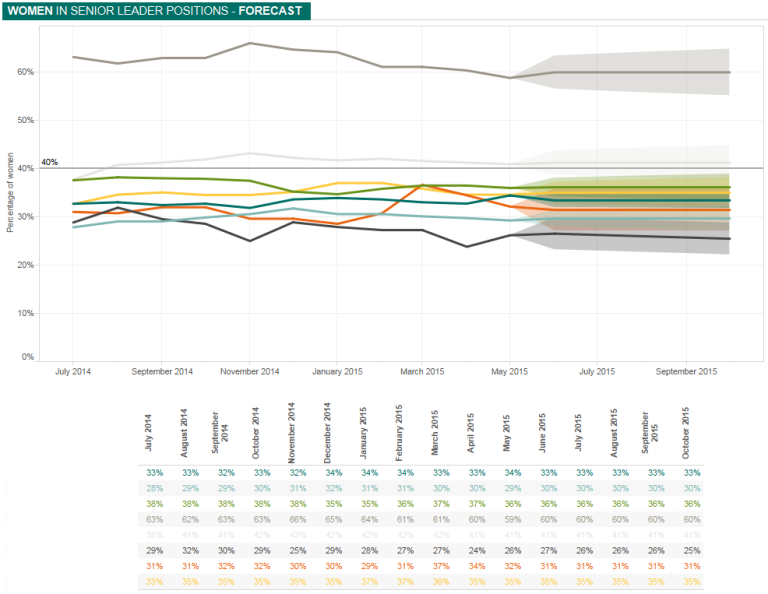Being diverse and inclusive is essential for any modern organisation. Without a reputation and strategy for accepting employees from a range of backgrounds your organisation will fail to fill vacant, critical roles. Without those roles you will struggle to build innovative products and services, deliver complex strategies in an unpredictable market and forge resiliency into your workforce. Despite these clear benefits only one-third of Australian organisations believe that being diverse and inclusive would support their market growth and customer satisfaction (see Diversity Council Australia).
The following 5 techniques provide a way for an organisation to thrive by fostering a diverse and inclusive workforce.
1. The Internal Labour Market map

Popularised by Mercer, the ILM map (or diagram) provides a broad view across recruitment, employment, promotion and terminations for your entire organisation. Similar to the example above, the diagram can be split across the paybands of an organisation and focus on specific demographic attributes, like gender. The biggest advantage of the ILM is that it intuitively summaries the flow of employees in, across and out of the organisation. The horizontal bar graph and arrows shows the number of employees and the proportion by gender. With the whole organisation represented in one diagram, you can quickly identify problem areas where certain minorities may be exiting are higher than average rates or where they face a ceiling for promotions.
2. Markov diagram

A Markov diagram takes the snapshot view provide by the ILM and shows the flow of talent from one period to the next. It can highlight churn within certain roles, identify trends from period to period, and dig deeper into the root cause of issues.
3. Employment target analysis

Targets to recruit employees from diverse backgrounds provides a clear way of ensuring your organisation becomes more inclusive. But it’s one thing to set a target – it’s another to know if you’re on track to reach it. Forecasting can provide insight into which areas in your organisation are already on track even if they haven’t met their target yet and, conversely, can highlight those areas that, while currently exceeding the target may drop below it in the coming months.
In addition to showing the future trajectory of your organisation’s recruitment effort, employment target analysis can also be used to model the potential impact of new diversity strategies. For example, if you identify a new recruitment channel to advertise for mature age workers, you can forecast the expected increase to see if that project will allow you to meet your target. In reality, you’ll usually need to model the impact of a number of different strategies to determine which will work in combination the best. Value driver modelling can explicitly consider the impact of interrelated strategies while still calculating a forecast without double counting benefits.
4. Retention drivers
 Retention and turnover metrics provided oversight for how your organisation’s retention strategies have worked. However, they don’t tell you how well your strategies will continue to work and if you’re targeting the right factors that actually improve retention. Being able to identify which aspects of your organisation actually contributes to retaining talented employees is much more valuable. A sensitivity analysis like the example above can provide this insight as well as show their relative impact.
Retention and turnover metrics provided oversight for how your organisation’s retention strategies have worked. However, they don’t tell you how well your strategies will continue to work and if you’re targeting the right factors that actually improve retention. Being able to identify which aspects of your organisation actually contributes to retaining talented employees is much more valuable. A sensitivity analysis like the example above can provide this insight as well as show their relative impact.
5. Employee segmentation and profiling

Customer or market segmentation has had a dramatic impact on the way organisations market and sell to consumers. By not treating all customers the same and targeting products and services to niches has given rise to whole new businesses. This same approach can be used for the design of recruitment, training, retention and succession strategies. This is even more so when dealing with employees from diverse backgrounds in the workplace that can be ostracized by a “one size fits all” approach to management. Importantly, employee segmentation is not about designing strategies based on arbitrary attributes like race and gender. It’s wrong to assume, for example, that all women or all mature age workers will respond the same to a new strategy. Instead, you need to investigate further and look at meaningful differences like work location, income, education, work history, role type and performance to build a portfolio of different employee profiles.
Once you’ve identify these employee profiles you’ll be able to look at traditional metrics like absenteeism and turnover through a whole new lens. You’ll find that, when you considered these metrics previously they usually covered a broad employee group. But by using employee profiles, issues like poor turnover may not be common across a whole group but is instead isolated to a specific niche. The advantage of now knowing that the issue is coming from a niche, means you can design a tailored approach to meeting the needs of those specific employees.
Credit to Mercer for the employee segmentation slides above.


Thanks Rueben – this is really topical in our organisation at the moment
LikeLike
Certainly is. I’ve got a bunch of reference material if you think you might need it 🙂
LikeLike